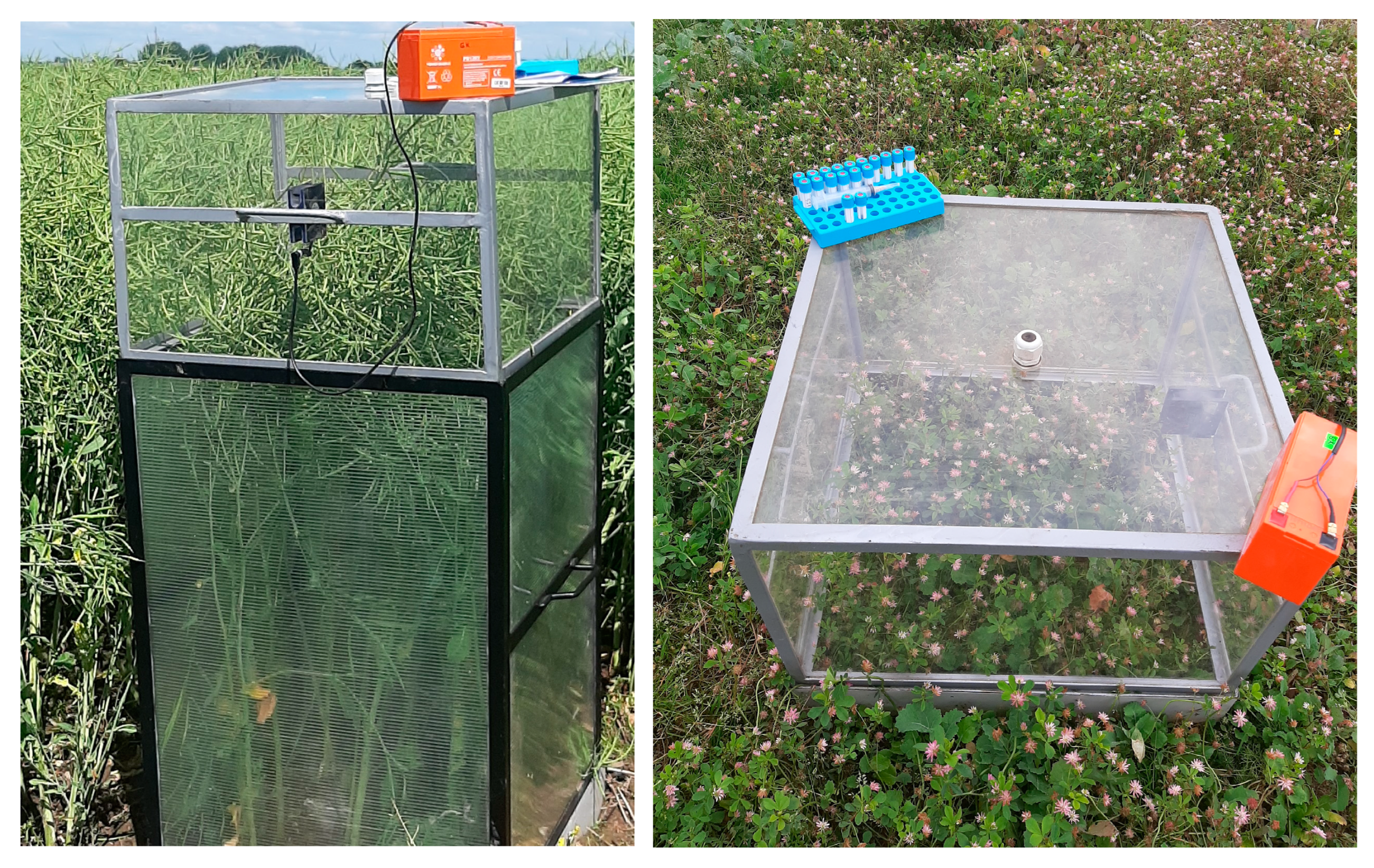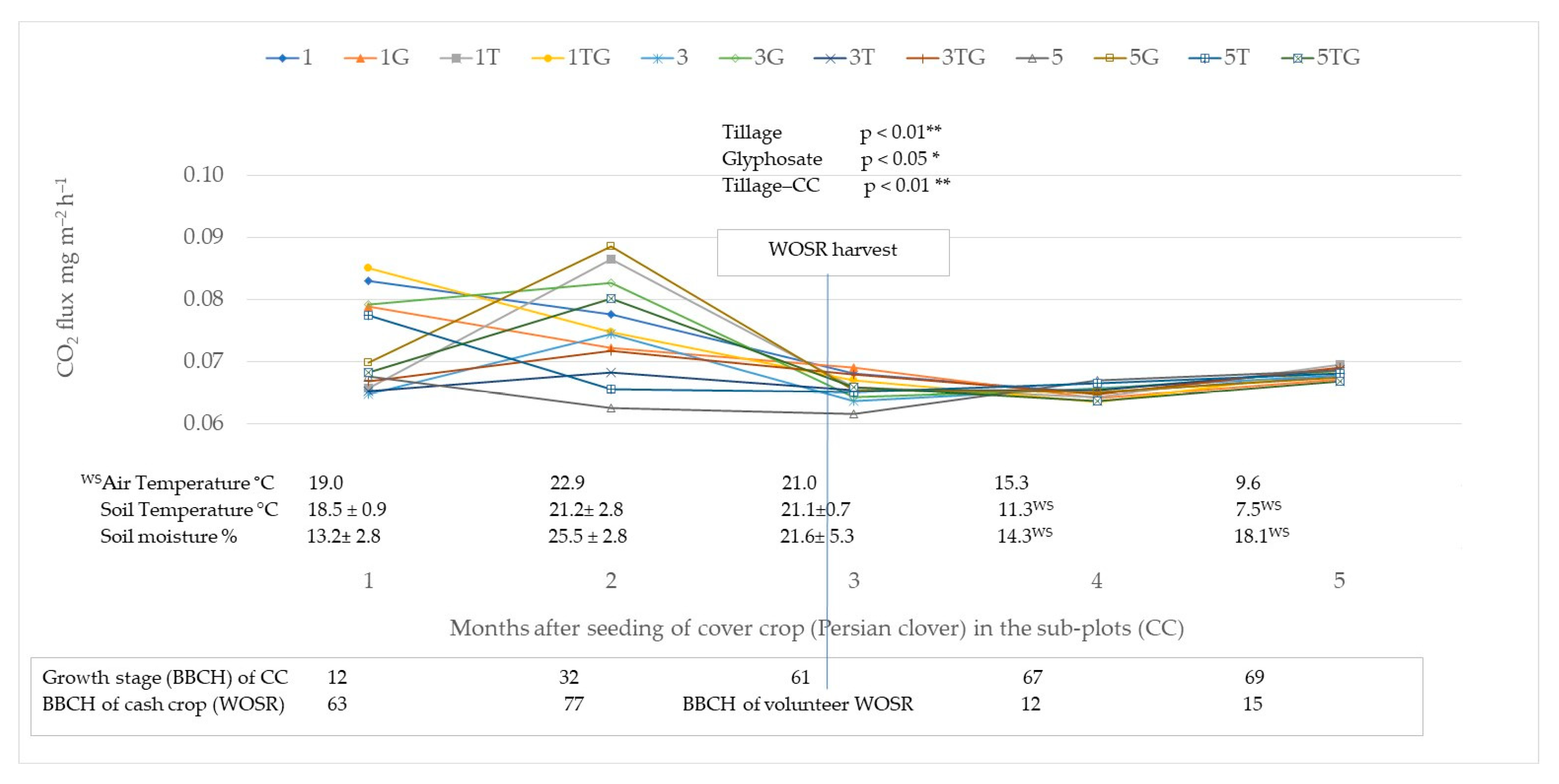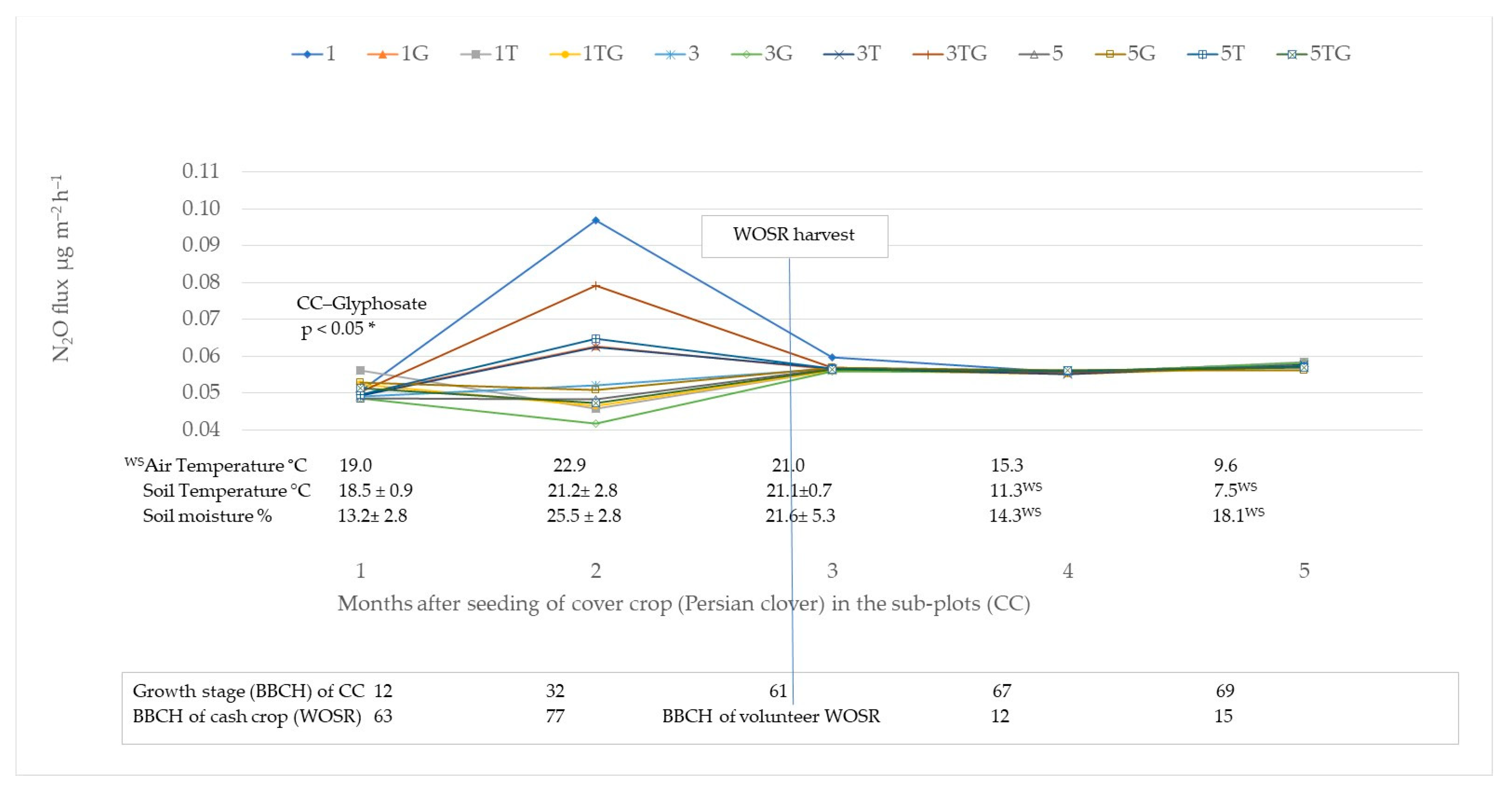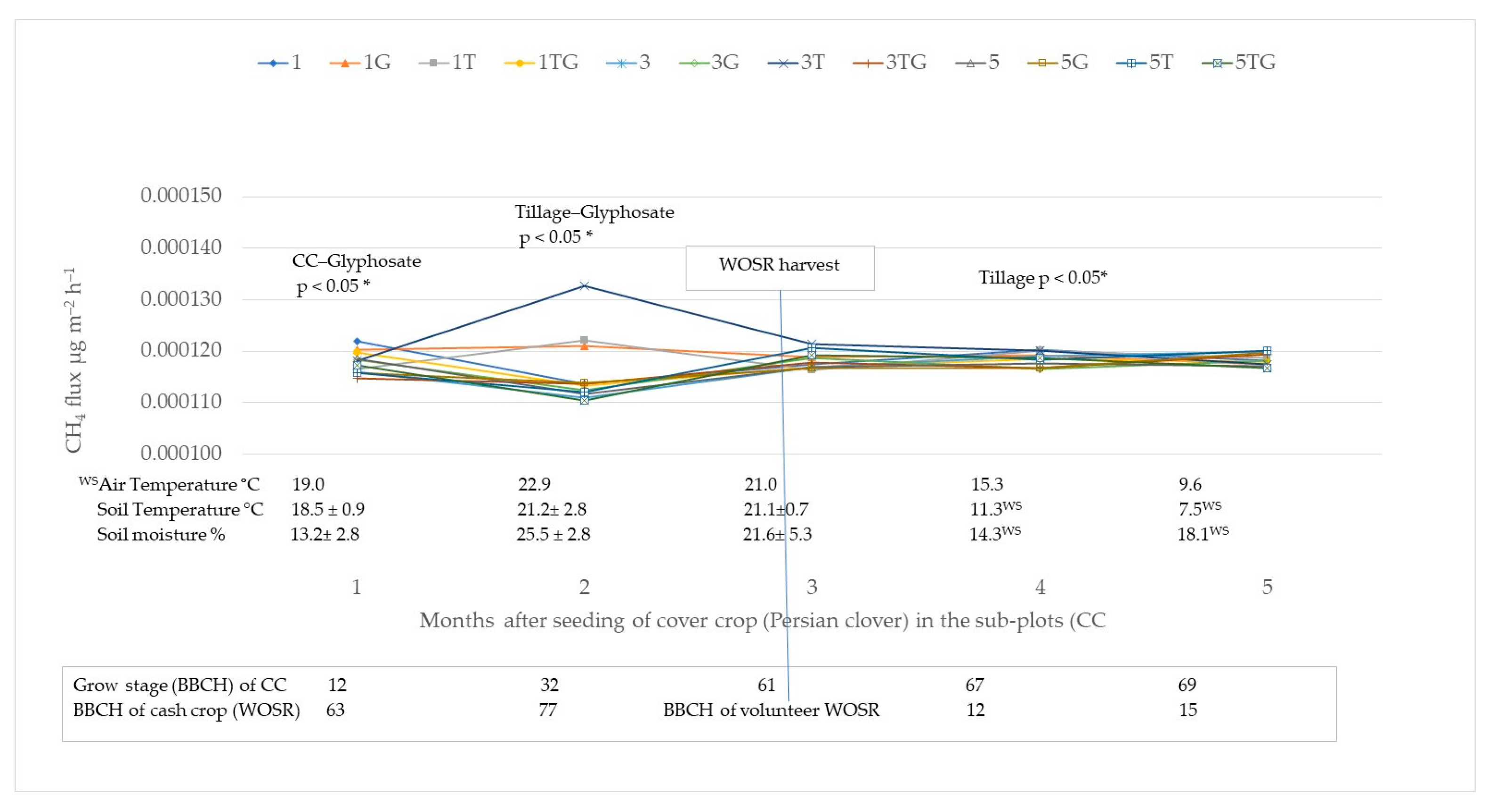Influence of the Long-Term Application of Management Practices (Tillage, Cover Crop and Glyphosate) on Greenhouse Gas Emissions and Soil Physical Properties
Abstract
1. Introduction
2. Materials and Methods
2.1. Site and Soil Description
2.2. Gas Sampling and Flux Calculation
2.3. Measurement of Soil Physical Properties
2.4. Statistical Analysis
3. Results
3.1. Greenhouse Gas Emissions
3.2. Global Warming Potential (GWP)
3.3. Meteorological Influence on GHG Fluxes
3.4. Soil Physical Properties
3.5. Relationships between Soil Physical Parameters and GHG Emissions
4. Discussion
4.1. Soil GHG Emissions
4.2. Soil Physical Parameters
5. Conclusions
Supplementary Materials
Author Contributions
Funding
Institutional Review Board Statement
Informed Consent Statement
Data Availability Statement
Acknowledgments
Conflicts of Interest
References
- Mandal, A.; Dhaliwal, S.S.; Mani, P.K.; Toor, A.S. Conservation agricultural practices under organic farming. In Advances in Organic Farming Agronomic Soil Management Practices; Woodhead Publishing: Oxford, UK, 2021; pp. 17–37. [Google Scholar] [CrossRef]
- Busari, M.A.; Kukal, S.S.; Kaur, A.; Bhatt, R.; Dulazi, A.A. Conservation tillage impacts on soil, crop and the environment. Int. Soil Water Conserv. Res. 2015, 3, 119–129. [Google Scholar] [CrossRef]
- Derpsch, R. Conservation Tillage, No-Tillage and Related Technologies. In Conservation Agriculture; Springer: Dordrecht, The Netherlands, 2003; pp. 181–190. Available online: https://link.springer.com/chapter/10.1007/978-94-017-1143-2_23 (accessed on 8 November 2023).
- Soane, B.D.; Ball, B.C.; Arvidsson, J.; Basch, G.; Moreno, F.; Roger-Estrade, J. No-till in northern, western and south-western Europe: A review of problems and opportunities for crop production and the environment. Soil Tillage Res. 2012, 118, 66–87. [Google Scholar] [CrossRef]
- Janusauskaite, D.; Kadziene, G. Influence of Different Intensities of Tillage on Physiological Characteristics and Productivity of Crop-Rotation Plants. Plants 2022, 11, 3107. [Google Scholar] [CrossRef] [PubMed]
- Lv, L.; Gao, Z.; Liao, K.; Zhu, Q.; Zhu, J. Impact of conservation tillage on the distribution of soil nutrients with depth. Soil Tillage Res. 2023, 225, 105527. [Google Scholar] [CrossRef]
- Kadžienė, G.; Pranaitienė, S.; Auškalnienė, O.; Veršulienė, A.; Supronienė, S.; Žvirdauskienė, R.; Gecaitė, V.; Cesevičienė, J.; Semaškienė, R. Oilseed Rape, Wheat, and Barley Grain Contamination as Affected by Different Glyphosate Usage. Plants 2023, 12, 1335. [Google Scholar] [CrossRef] [PubMed]
- Kanissery, R.; Gairhe, B.; Kadyampakeni, D.; Batuman, O.; Alferez, F. Glyphosate: Its environmental persistence and impact on crop health and nutrition. Plants 2019, 8, 499. [Google Scholar] [CrossRef] [PubMed]
- Gandhi, K.; Khan, S.; Patrikar, M.; Markad, A.; Kumar, N.; Choudhari, A.; Sagar, P.; Indurkar, S. Exposure risk and environmental impacts of glyphosate: Highlights on the toxicity of herbicide co-formulants. Environ. Chall. 2021, 4, 100149. [Google Scholar] [CrossRef]
- Hagner, M.; Mikola, J.; Saloniemi, I.; Saikkonen, K.; Helander, M. Effects of a glyphosate-based herbicide on soil animal trophic groups and associated ecosystem functioning in a northern agricultural field. Sci. Rep. 2019, 9, 8540. [Google Scholar] [CrossRef] [PubMed]
- Duke, S.O.; Powles, S.B. Glyphosate: A once-in-a-century herbicide. Pest Manag. Sci. 2008, 63, 1100–1106. [Google Scholar] [CrossRef]
- Nguyen, D.B.; Rose, M.T.; Rose, T.J.; Morris, S.G.; van Zwieten, L. Impact of glyphosate on soil microbial biomass and respiration: A meta-analysis. Soil Biol. Biochem. 2016, 92, 50–57. [Google Scholar] [CrossRef]
- Zaller, J.G.; Heigl, F.; Ruess, L.; Grabmaier, A. Glyphosate herbicide affects belowground interactions between earthworms and symbiotic mycorrhizal fungi in a model ecosystem. Sci. Rep. 2014, 4, 5634. Available online: https://www.nature.com/articles/srep05634 (accessed on 17 March 2024). [CrossRef]
- Farmaha, B.S.; Sekaran, U.; Franzluebbers, A.J. Cover cropping and conservation tillage improve soil health in the southeastern United States. Agron. J. 2022, 114, 296–316. [Google Scholar] [CrossRef]
- Quintarelli, V.; Radicetti, E.; Allevato, E.; Stazi, S.R.; Haider, G.; Abideen, Z.; Bibi, S.; Jamal, A.; Mancinelli, R. Cover Crops for Sustainable Cropping Systems: A Review. Agriculture 2022, 12, 2076. [Google Scholar] [CrossRef]
- Koudahe, K.; Allen, S.C.; Djaman, K. Critical review of the impact of cover crops on soil properties. Int. Soil Water Conserv. Res. 2022, 10, 343–354. [Google Scholar] [CrossRef]
- Rühlemann, L.; Schmidtke, K. The suitability of non-legume cover crops for inorganic soil nitrogen immobilisation in the transition period to an organic no-till system. Plant Prod. Sci. 2016, 19, 105–124. Available online: https://www.tandfonline.com/action/journalInformation?journalCode=tpps20 (accessed on 26 November 2023). [CrossRef]
- Ali, S.; Zahid, A.; Fatima, A.; Ahmad, M.; Manzoor, M.T.; Ayub, A.; Raza, A.; Shafqat, N.; Ali, S.; Zahid, A.; et al. Harnessing Soil Potential: Innovation in Strategic Tillage and Management—New Perspectives. Strateg Tillage Soil Manag—New Perspect 27 September 2023. Available online: https://www.intechopen.com/online-first/88226 (accessed on 8 November 2023).
- Seitz, S.; Goebes, P.; Puerta, V.L.; Pereira, E.I.P.; Wittwer, R.; Six, J.; van der Heijden, M.G.A.; Scholten, T. Conservation tillage and organic farming reduce soil erosion. Agron. Sustain. Dev. 2019, 39, 4. [Google Scholar] [CrossRef]
- Carter, M.R.; Sanderson, J.B.; Holmstrom, D.A.; Ivany, J.A.; DeHaan, K.R. Influence of conservation tillage and glyphosate on soil structure and organic carbon fractions through the cycle of a 3-year potato rotation in Atlantic Canada. Soil Tillage Res. 2007, 93, 206–221. [Google Scholar] [CrossRef]
- Soil Association. The impact of glyphosate on soil health Glyphosate and Soil. Soil Assoc. 2016, 1, 1–8. Available online: https://www.soilassociation.org/media/7202/glyphosate-and-soil-health-full-report.pdf (accessed on 17 March 2024).
- Wynn, S.; Webb, E. Impact assessment of the loss of glyphosate within the EU: A literature review. Environ. Sci. Eur. 2022, 34, 91. [Google Scholar] [CrossRef]
- Schad, P. The International Soil Classification System WRB, 2014, 3rd ed.; Springer Water; Springer: Berlin/Heidelberg, Germany, 2016; pp. 563–571. ISBN 9789251083697. [Google Scholar]
- ISO 10694:1995; Soil Quality—Determination of Organic and Total Carbon after Dry Combustion (Elementary Analysis). ISO: Geneva, Switzerland, 1995.
- Egner, H.; Riehm, H.; Domingo, W.R. Untersuchungen über die chemische Bodenanalyse als Grundlage für die Beurteilung des Nährstoffzustandes der Böden II. Chemische Extraktionsmethoden zur Phosphor-und Kaliumbestimmung. K. Landbr. 1960, 26, 199–215. [Google Scholar]
- Kanerva, T.; Regina, K.; Rämö, K.; Ojanperä, K.; Manninen, S. Fluxes of N2O, CH4 and CO2 in a meadow ecosystem exposed to elevated ozone and carbon dioxide for three years. Environ. Pollut. 2007, 145, 818–828. Available online: https://linkinghub.elsevier.com/retrieve/pii/S0269749106003307 (accessed on 22 November 2023). [CrossRef]
- Doyeni, M.O.; Stulpinaite, U.; Baksinskaite, A.; Suproniene, S.; Tilvikiene, V. Greenhouse gas emissions in agricultural cultivated soils using animal waste-based digestates for crop fertilization. J. Agric. Sci. 2021, 159, 23–30. [Google Scholar] [CrossRef]
- Hoffmann, M.; Wirth, S.J.; Beßler, H.; Engels, C.; Jochheim, H.; Sommer, M.; Augustin, J. Combining a root exclusion technique with continuous chamber and porous tube measurements for a pin-point separation of ecosystem respiration in croplands. J. Plant Nutr. Soil Sci. 2018, 181, 41–50. [Google Scholar] [CrossRef]
- R Core Team. R: A Language and Environment for Statistical Computing; R Foundation for Statistical Computing: Vienna, Austria, 2023; Available online: https://www.R-project.org/ (accessed on 17 March 2024).
- Lewis, E.; Chamel, O.; Mohsenin, M.; Ots, E.; White, E.T. Intergovernmental Panel on Climate Change. In Sustainaspeak; Routledge: New York, NY, USA, 2018; pp. 153–154. Available online: https://www.taylorfrancis.com/books/9781351981736/chapters/10.4324/9781315270326-109 (accessed on 20 December 2023).
- Mangalassery, S.; Sjögersten, S.; Sparkes, D.L.; Sturrock, C.J.; Craigon, J.; Mooney, S.J. To what extent can zero tillage lead to a reduction in greenhouse gas emissions from temperate soils? Sci. Rep. 2014, 4, 4586. [Google Scholar] [CrossRef] [PubMed]
- Oertel, C.; Matschullat, J.; Zurba, K.; Zimmermann, F.; Erasmi, S. Greenhouse gas emissions from soils—A review. Chem. Erde Geochem. 2016, 76, 327–352. [Google Scholar] [CrossRef]
- Dong, W.; Liu, E.; Wang, J.; Yan, C.; Li, J.; Zhang, Y. Impact of tillage management on the short- and long-term soil carbon dioxide emissions in the dryland of Loess Plateau in China. Geoderma 2017, 307, 38–45. [Google Scholar] [CrossRef]
- Mühlbachová, G.; Kusá, H.; Růžek, P.; Vavera, R. CO2 emissions in a soil under different tillage practices. Plant Soil Environ. 2022, 68, 253–261. [Google Scholar] [CrossRef]
- Gui, W.; You, Y.; Yang, F.; Zhang, M. Soil Bulk Density and Matric Potential Regulate Soil CO2 Emissions by Altering Pore Characteristics and Water Content. Land 2023, 12, 1646. [Google Scholar] [CrossRef]
- Matzrafi, M.; Brunharo, C.; Tehranchian, P.; Hanson, B.D.; Jasieniuk, M. Increased temperatures and elevated CO2 levels reduce the sensitivity of Conyza canadensis and Chenopodium album to glyphosate. Sci. Rep. 2019, 9, 2228. Available online: www.nature.com/scientificreports (accessed on 26 November 2023). [CrossRef]
- Zobiole, L.H.S.; Kremer, R.J.; de Oliveira, R.S., Jr.; Constantin, J. Glyphosate effects on photosynthesis, nutrient accumulation, and nodulation in glyphosate-resistant soybean. J. Plant Nutr. Soil Sci. 2012, 175, 319–330. [Google Scholar] [CrossRef]
- Petersen, S.O.; Mutegi, J.K.; Hansen, E.M.; Munkholm, L.J. Tillage effects on N2O emissions as influenced by a winter cover crop. Soil Biol. Biochem. 2011, 43, 1509–1517. [Google Scholar] [CrossRef]
- Rutkowska, B.; Szulc, W.; Szara, E.; Skowrońska, M.; Jadczyszyn, T. Soil N2O emissions under conventional and reduced tillage methods and maize cultivation. Plant Soil Environ. 2017, 63, 342–347. [Google Scholar] [CrossRef]
- Sosulski, T.; Szara, E.; Szymańska, M.; Stępień, W.; Rutkowska, B.; Szulc, W. Soil N2O emissions under conventional tillage conditions and from forest soil. Soil Tillage Res. 2019, 190, 86–91. [Google Scholar] [CrossRef]
- Lognoul, M.; Theodorakopoulos, N.; Hiel, M.P.; Regaert, D.; Broux, F.; Heinesch, B.; Bodson, B.; Vandenbol, M.; Aubinet, M. Impact of tillage on greenhouse gas emissions by an agricultural crop and dynamics of N2O fluxes: Insights from automated closed chamber measurements. Soil Tillage Res. 2017, 167, 80–89. [Google Scholar] [CrossRef]
- Azam, F.; Müller, C.; Weiske, A.; Benckiser, G.; Ottow, J.C.G. Nitrification and denitrification as sources of atmospheric nitrous oxide—Role of oxidizable carbon and applied nitrogen. Biol. Fertil. Soils 2002, 35, 54–61. [Google Scholar] [CrossRef]
- Tribouillois, H.; Constantin, J.; Justes, E. Cover crops mitigate direct greenhouse gases balance but reduce drainage under climate change scenarios in temperate climate with dry summers. Glob. Chang. Biol. 2018, 24, 2513–2529. [Google Scholar] [CrossRef] [PubMed]
- Wang, Y.; Saikawa, E.; Avramov, A.; Hill, N.S. Agricultural Greenhouse Gas Fluxes Under Different Cover Crop Systems. Front. Clim. 2022, 3, 742320. [Google Scholar] [CrossRef]
- Anuo, C.O.; Cooper, J.A.; Koehler-Cole, K.; Ramirez, S.; Kaiser, M. Effect of cover cropping on soil organic matter characteristics: Insights from a five-year field experiment in Nebraska. Agric. Ecosyst. Environ. 2023, 347, 108393. [Google Scholar] [CrossRef]
- Slepetiene, A.; Kadziene, G.; Suproniene, S.; Skersiene, A. The Content and Stratification of SOC and Its Humified Fractions Using Different Soil Tillage and Inter-Cropping. Sustainability 2024, 16, 953. [Google Scholar] [CrossRef]
- Horn, R.; Taubner, H.; Wuttke, M.; Baumgartl, T. Soil physical properties related to soil structure. Soil Tillage Res. 1994, 30, 187–216. [Google Scholar] [CrossRef]
- Totsche, K.U.; Amelung, W.; Gerzabek, M.H.; Guggenberger, G.; Klumpp, E.; Knief, C.; Lehndorff, E.; Mikutta, R.; Peth, S.; Prechtel, A.; et al. Microaggregates in soils. J. Plant Nutr. Soil Sci. 2018, 181, 104–136. [Google Scholar] [CrossRef]
- Liu, Z.; Cao, S.; Sun, Z.; Wang, H.; Qu, S.; Lei, N.; He, J.; Dong, Q. Tillage effects on soil properties and crop yield after land reclamation. Sci. Rep. 2021, 11, 4611. [Google Scholar] [CrossRef] [PubMed]
- Mahboubi, A.A.; Lal, R.; Faussey, N.R. Twenty-Eight Years of Tillage Effects on Two Soils in Ohio. Soil Sci. Soc. Am. J. 1993, 57, 506–512. Available online: https://onlinelibrary.wiley.com/doi/full/10.2136/sssaj1993.03615995005700020034x (accessed on 17 March 2024). [CrossRef]
- Strudley, M.W.; Green, T.R.; Ascough, J.C. Tillage effects on soil hydraulic properties in space and time: State of the science. Soil Tillage Res. 2008, 99, 4–48. [Google Scholar] [CrossRef]
- Blanco-Canqui, H.; Shaver, T.M.; Lindquist, J.L.; Shapiro, C.A.; Elmore, R.W.; Francis, C.A.; Hergert, G.W. Cover crops and ecosystem services: Insights from studies in temperate soils. Agron. J. 2015, 107, 2449–2474. [Google Scholar] [CrossRef]
- Gozubuyuk, Z.; Sahin, U.; Adiguzel, M.C.; Ozturk, I.; Celik, A. The influence of different tillage practices on water content of soil and crop yield in vetch–winter wheat rotation compared to fallow–winter wheat rotation in a high altitude and cool climate. Agric. Water Manag. 2015, 160, 84–97. [Google Scholar] [CrossRef]
- Rahman, M.H.; Okubo, A.; Sugiyama, S.; Mayland, H.F. Physical, chemical and microbiological properties of an Andisol as related to land use and tillage practice. Soil Tillage Res. 2008, 101, 10–19. [Google Scholar] [CrossRef]
- Eigenberg, R.A.; Doran, J.W.; Nienaber, J.A.; Ferguson, R.B.; Woodbury, B.L. Electrical conductivity monitoring of soil condition and available N with animal manure and a cover crop. Agric. Ecosyst. Environ. 2002, 88, 183–193. [Google Scholar] [CrossRef]
- Visconti, F.; de Paz, J.M. Electrical Conductivity Measurements in Agriculture: The Assessment of Soil Salinity. New Trends Dev. Metrol. 2016, 1, 99–126. [Google Scholar] [CrossRef]




| Treatments | VWC % Vol | EC mS m−1 | WFPS % | Temp °C | BD g cm−3 | WSA% | TP m3 m−3 |
|---|---|---|---|---|---|---|---|
| 1 | 18.68 ± 1.36 ab | 11.13 ± 0.90 ab | 43.87 ± 3.19 ab | 20.87 ± 0.59 ab | 1.49 ± 0.03 b | 69.63 ± 1.63 b | 0.44 ± 0.011 a |
| 3 | 18.08 ± 0.47 ab | 10.62 ± 1.19 ab | 42.46 ± 1.09 ab | 20.20 ± 0.32 ab | 1.53 ± 0.01 ab | 79.17 ± 4.09 ab | 0.42 ± 0.004 ab |
| 5 | 19.58 ± 1.16 ab | 11.69 ± 1.60 ab | 45.98 ± 2.73 ab | 20.01 ± 0.23 b | 1.54 ± 0.01 ab | 81.4 ± 2.92 a | 0.42 ± 0.004 ab |
| 1T | 23.57 ± 1.43 a | 16.16 ± 0.68 a | 55.35 ± 3.37 a | 20.17 ± 0.10 ab | 1.48 ± 0.02 b | 68.36 ± 0.94 b | 0.44 ± 0.007 a |
| 3T | 20.92 ± 2.09 ab | 12.16 ± 2.11 ab | 49.14 ± 4.91 ab | 19.34 ± 0.14 b | 1.52 ± 0.01 ab | 73.86 ± 0.68 ab | 0.43 ± 0.003 ab |
| 5T | 21.86 ± 0.50 ab | 14.76 ± 1.24 ab | 51.33 ± 1.17 ab | 20.01 ± 0.29 b | 1.59 ± 0.01 a | 78.21 ± 0.81 ab | 0.40 ± 0.005 b |
| 1G | 19.14 ± 0.41 ab | 11.68 ± 0.96 ab | 44.96 ± 0.97 ab | 22.57 ± 1.42 a | 1.49 ± 0.03 b | 69.63 ± 1.63 b | 0.44 ± 0.011 a |
| 3G | 17.48 ± 1.00 b | 9.43 ± 0.77 b | 41.05 ± 2.34 b | 20.19 ± 0.32 ab | 1.53 ± 0.01 ab | 79.17 ± 4.09 ab | 0.42 ± 0.004 ab |
| 5G | 20.23 ± 0.47 ab | 13.01 ± 0.60 ab | 47.52 ± 1.10 ab | 20.43 ± 0.14 ab | 1.54 ± 0.01 ab | 81.40 ± 2.92 a | 0.42 ± 0.004 ab |
| 1TG | 20.71 ± 1.69 ab | 12.89 ± 1.51 ab | 48.64 ± 3.96 ab | 20.05 ± 0.27 b | 1.48 ± 0.02 b | 68.36 ± 0.94 b | 0.44 ± 0.007 a |
| 3TG | 20.41 ± 0.94 ab | 11.39 ± 0.57 ab | 47.93 ± 2.22 ab | 19.61 ± 0.05 b | 1.52 ± 0.01 ab | 73.86 ± 0.68 ab | 0.43 ± 0.003 ab |
| 5TG | 20.53 ± 0.99 ab | 12.70 ± 0.78 ab | 48.22 ± 2.31 ab | 19.67 ± 0.19 b | 1.59 ± 0.01 a | 78.2 ± 0.81 ab | 0.40 ± 0.005 b |
| VWC | Temp | EC | WFPS | BD | TP | WSA | CO2 | N2O | CH4 | |
|---|---|---|---|---|---|---|---|---|---|---|
| VWC | –0.22 | 0.9 ** | 0.94 ** | –0.03 | –0.01 | –0.19 | –0.26 | 0.18 | 0.14 | |
| Temp | –0.06 | –0.31 | –0.35 * | 0.39 * | –0.28 | 0.3 | –0.08 | 0.25 | ||
| EC | 0.87 ** | 0.03 | –0.06 | –0.18 | –0.16 | 0.15 | 0.05 | |||
| WFPS | 0.3 | –0.34 | –0.02 | –0.31 | 0.18 | 0.01 | ||||
| BD | –0.99 ** | 0.51 ** | –0.18 | 0.04 | –0.39 * | |||||
| TP | –0.54 ** | 0.18 | –0.12 | 0.37 * | ||||||
| WSA | –0.12 | 0.11 | –0.07 | |||||||
| CO2 | 0.14 | 0.28 | ||||||||
| N2O | 0.06 | |||||||||
| CH4 |
Disclaimer/Publisher’s Note: The statements, opinions and data contained in all publications are solely those of the individual author(s) and contributor(s) and not of MDPI and/or the editor(s). MDPI and/or the editor(s) disclaim responsibility for any injury to people or property resulting from any ideas, methods, instructions or products referred to in the content. |
© 2024 by the authors. Licensee MDPI, Basel, Switzerland. This article is an open access article distributed under the terms and conditions of the Creative Commons Attribution (CC BY) license (https://creativecommons.org/licenses/by/4.0/).
Share and Cite
Doyeni, M.O.; Suproniene, S.; Versuliene, A.; Meskauskiene, L.; Kadziene, G. Influence of the Long-Term Application of Management Practices (Tillage, Cover Crop and Glyphosate) on Greenhouse Gas Emissions and Soil Physical Properties. Sustainability 2024, 16, 2859. https://doi.org/10.3390/su16072859
Doyeni MO, Suproniene S, Versuliene A, Meskauskiene L, Kadziene G. Influence of the Long-Term Application of Management Practices (Tillage, Cover Crop and Glyphosate) on Greenhouse Gas Emissions and Soil Physical Properties. Sustainability. 2024; 16(7):2859. https://doi.org/10.3390/su16072859
Chicago/Turabian StyleDoyeni, Modupe Olufemi, Skaidre Suproniene, Agne Versuliene, Loreta Meskauskiene, and Grazina Kadziene. 2024. "Influence of the Long-Term Application of Management Practices (Tillage, Cover Crop and Glyphosate) on Greenhouse Gas Emissions and Soil Physical Properties" Sustainability 16, no. 7: 2859. https://doi.org/10.3390/su16072859
APA StyleDoyeni, M. O., Suproniene, S., Versuliene, A., Meskauskiene, L., & Kadziene, G. (2024). Influence of the Long-Term Application of Management Practices (Tillage, Cover Crop and Glyphosate) on Greenhouse Gas Emissions and Soil Physical Properties. Sustainability, 16(7), 2859. https://doi.org/10.3390/su16072859








